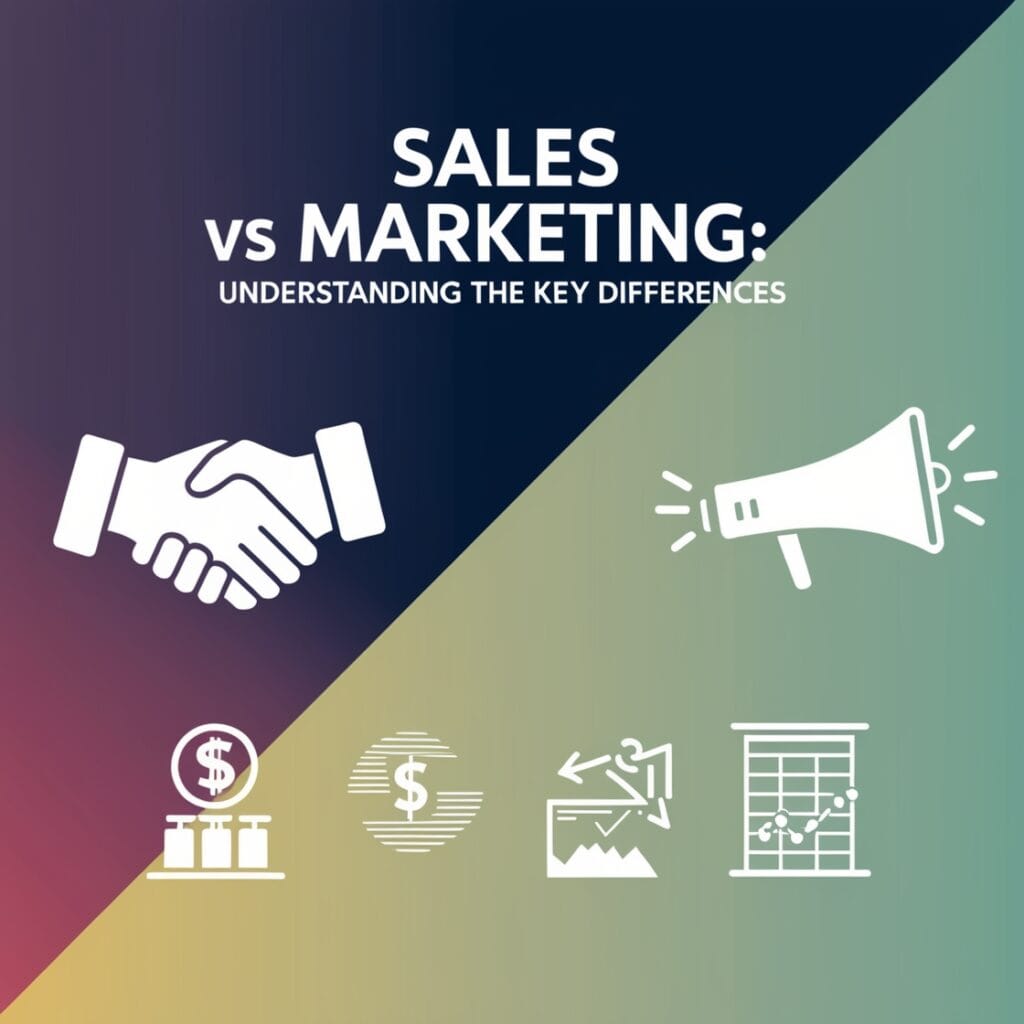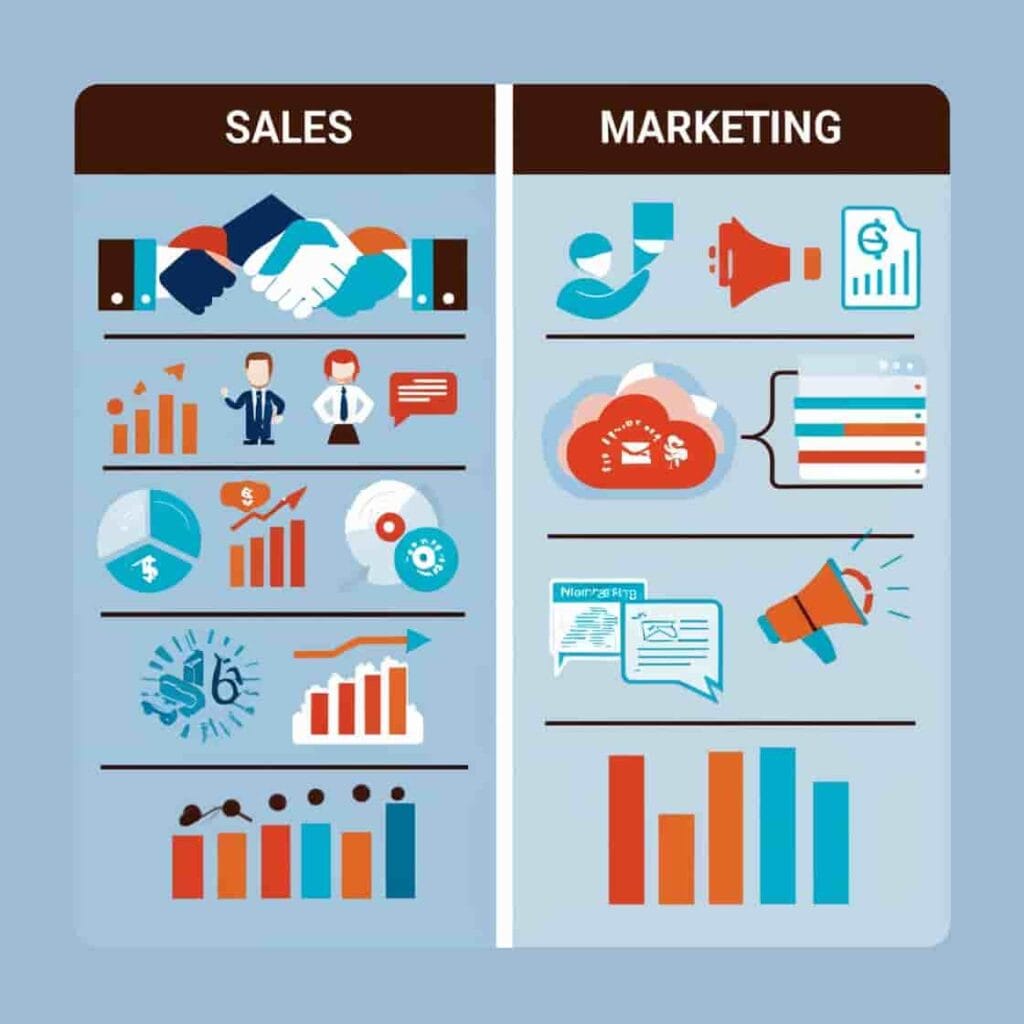Introduction
Sales and marketing are two integral pillars of any successful business. They share the ultimate goal of driving revenue and ensuring business growth, but their approaches, functions, and strategies differ significantly. While marketing lays the groundwork for customer engagement and brand building, sales focuses on closing the deal and generating direct revenue. Understanding these distinctions and their interdependence is crucial for businesses aiming to create cohesive strategies.
This blog explores the nuanced differences between sales and marketing in detail, covering their definitions, key functions, collaboration dynamics, and more.
Difference Between Sales and Marketing
What is Sales?
Sales is the direct process of persuading potential customers to purchase a product or service. It involves personal interactions, negotiations, and closing deals to generate revenue. Sales professionals focus on building relationships, addressing specific customer needs, and meeting revenue targets within a defined timeframe.

Key Functions of Sales:
- Lead Conversion: Transforming qualified leads into paying customers through effective communication and persuasion.
- Customer Relationship Management: Building and maintaining relationships to encourage repeat business and referrals.
- Negotiation: Addressing customer concerns and objections to finalize a mutually beneficial agreement.
- Target Achievement: Meeting specific sales quotas and revenue goals within a designated period.
- Feedback Collection: Gathering insights about customer preferences and challenges to improve product offerings and processes.
Difference Between Sales and Marketing
What is Marketing?
Marketing encompasses a broader range of activities aimed at creating brand awareness, generating interest, and driving traffic or leads to the sales funnel. It involves understanding customer needs, analyzing market trends, and crafting strategies to position the brand effectively.

Key Functions of Marketing:
- Market Research: Understanding customer behavior, preferences, and market trends to guide decision-making.
- Brand Building: Creating a unique brand identity and messaging that resonates with the target audience.
- Campaign Development: Designing and executing promotional campaigns to generate leads and drive engagement.
- Content Creation: Producing engaging materials, such as blog posts, videos, and social media updates, to attract and inform audiences.
- Performance Analysis: Measuring the effectiveness of marketing campaigns to refine strategies and achieve better results.
Key Differences Between Sales and Marketing

| Aspect | Sales | Marketing |
| Focus | Closing deals and generating revenue | Building awareness and generating leads |
| Timeframe | Short-term goals (immediate conversions) | Long-term goals (brand equity, loyalty) |
| Approach | Direct, interpersonal | Indirect, strategic |
| Activities | Negotiating, pitching, closing deals | Research, advertising, content creation |
| Metrics | Sales figures, deal closures, revenue | Traffic, lead generation, campaign ROI |
| Audience Interaction | One-on-one, personalized communication | Mass communication and segmentation |
How Sales and Marketing Work Together
Though distinct, sales and marketing are interdependent. A well-coordinated strategy ensures that marketing efforts generate high-quality leads, which the sales team can then convert effectively. Here’s how they complement each other:

1. Lead Generation and Conversion
- Marketing’s Role: Attract and engage potential customers through campaigns, social media, and SEO.
- Sales’ Role: Follow up with qualified leads, nurture them, and convert them into paying customers.
2. Feedback Loop
- Sales to Marketing: Sales teams provide direct feedback on customer pain points, preferences, and objections.
- Marketing to Sales: Marketing refines messaging and strategies based on sales feedback, ensuring better alignment.
3. Aligned Objectives
- Both departments aim to drive revenue, with marketing focusing on awareness and interest, and sales targeting closure.
4. Tools and Technology
- Shared platforms like CRM systems and analytics tools help both teams track customer interactions and measure performance.
Examples of Sales vs. Marketing Activities ( Difference Between Sales and Marketing)

Sales Activities:
- Cold Calling: Reaching out to potential customers directly.
- Product Demonstrations: Offering personalized demos to show product value.
- Follow-ups: Regularly contacting leads to maintain interest and resolve objections.
- Negotiations: Addressing pricing, terms, and conditions to finalize deals.
Marketing Activities:
- Social Media Campaigns: Running paid and organic campaigns to attract traffic.
- Content Marketing: Publishing blog posts, videos, and infographics to educate and engage audiences.
- SEO and SEM: Optimizing content for search engines to improve visibility.
- Email Marketing: Sending newsletters and promotional emails to nurture leads.
The Importance of Sales and Marketing Alignment

When sales and marketing teams work in harmony, the results can be transformative. Alignment leads to better lead quality, higher conversion rates, and a unified customer experience. Here’s why alignment matters:

1. Improved Lead Quality
Marketing can focus on generating high-quality leads that match the sales team’s ideal customer profile, ensuring better conversion rates.
2. Consistent Messaging
When both teams share a common understanding of the brand’s value proposition, customers receive consistent messaging throughout their journey.
3. Enhanced Customer Experience
Seamless collaboration ensures that potential customers receive timely and relevant interactions, improving their overall experience.
4. Increased Revenue
Aligned teams work more efficiently, resulting in better utilization of resources and higher revenue generation.
Challenges in Sales and Marketing Coordination (Difference Between Sales and Marketing)
Despite their importance, aligning sales and marketing teams can be challenging. Common obstacles include:
- Communication Gaps: Misaligned goals and lack of regular communication can create silos.
- Differing KPIs: While sales teams focus on revenue, marketing teams often measure success through metrics like traffic and engagement.
- Technology Barriers: Inconsistent or incompatible tools can hinder collaboration.
Strategies for Bridging the Gap
To foster better collaboration between sales and marketing, businesses can:
- Define Shared Goals: Establish common objectives that both teams work toward, such as revenue targets or customer acquisition rates.
- Regular Communication: Hold regular meetings to discuss progress, challenges, and opportunities.
- Implement Shared Tools: Use integrated platforms like CRM systems to track and share data seamlessly.
- Cross-Training: Provide opportunities for team members to understand each other’s roles and responsibilities.
Real-World Example: Sales and Marketing Collaboration
Difference Between Sales and Marketing
Consider a software company launching a new product. The marketing team runs a digital campaign highlighting the product’s features and benefits, generating hundreds of leads. The sales team then follows up with these leads, offering personalized demos and addressing specific customer needs. By working together, the teams successfully convert a significant percentage of leads into paying customers.
Sales and marketing serve distinct but complementary purposes in any business. Marketing focuses on creating awareness and generating interest, while sales drives revenue by converting leads into customers. Both functions are essential, and their collaboration can unlock significant business growth.
By aligning goals, leveraging shared tools, and fostering open communication, businesses can create a seamless customer journey and achieve long-term success.

